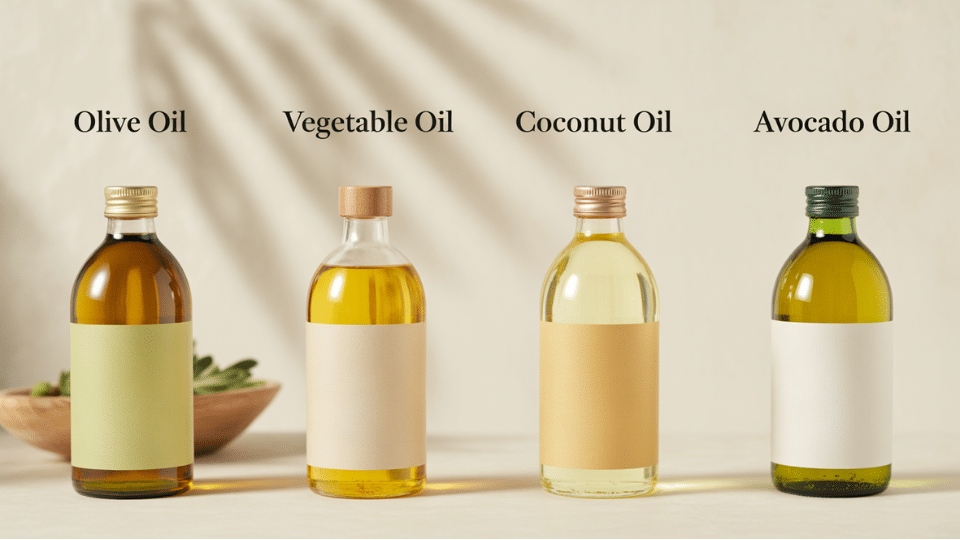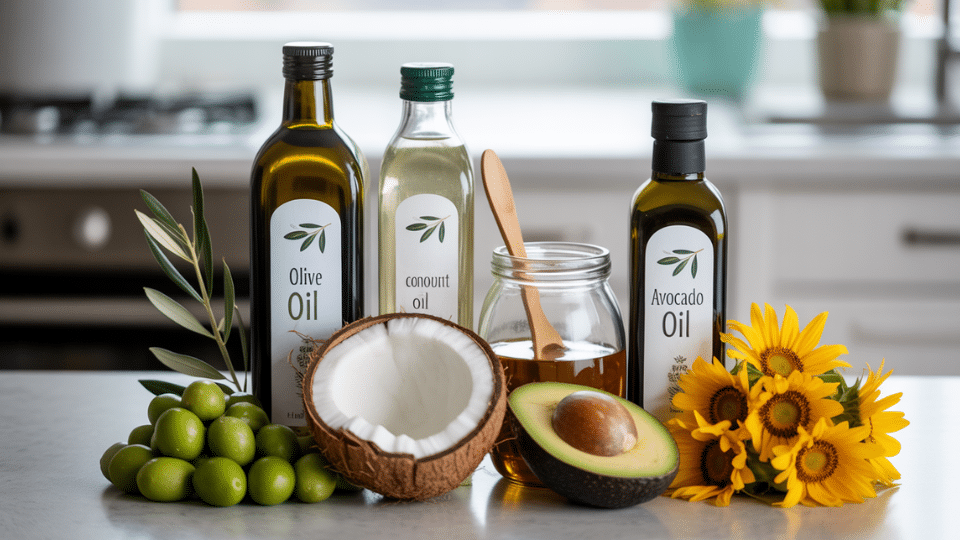Ever feel lost when picking cooking oil at the store? So many bottles, so little clarity!
In this blog, I’ll show you how to pick the best cooking oil without having to walk those long aisles of grocery stores.
Choosing the right oil can enhance the taste of your food and promote your health.
Cooking oils aren’t all the same. Some work great for frying, while others are perfect for salads.
I’ll break down everything you need to know about cooking oils in simple, easy steps.
No fancy words, just clear advice to help you cook smarter.
Understanding The Basics of Cooking Oil

Choosing the best oil for cooking creates a gap that is filled by understanding the basics of all the oils. Below mentioned are some of the most commonly used oils and their cooking details:
1. Olive Oil
Olive oil is a true health champion in the kitchen.
It’s perfect for low-heat cooking and making salad dressings.
You’ll find two main types: extra virgin and regular olive oil.
Extra-virgin olive oil has a milder, more pleasant taste and is rich in healthy fats. It’s great for drizzling over salads or using in light cooking.
2. Vegetable Oil
Vegetable oil is the go-to all-purpose option for many home cooks.
It works wonderfully for frying and baking, thanks to its neutral flavor and affordable price.
When you need an oil that can handle various cooking methods without imparting a strong taste, vegetable oil is your best choice.
It’s versatile and withstands various cooking temperatures well.
3. Coconut Oil
Coconut oil brings a tropical twist to your cooking.
It’s solid at room temperature and adds a sweet flavor to baked goods.
Packed with medium-chain triglycerides, it’s considered a healthier fat option.
Coconut oil works best in medium-heat cooking and baking, adding a unique and delightful taste to your dishes.
4. Avocado Oil
Avocado oil is the high-heat hero of cooking oils.
It can handle grilling and sautéing like a champ, with the highest smoke point among common cooking oils.
Though more expensive, it offers a slightly nutty flavor and is rich in healthy fats.
Chefs and health-conscious home cooks love avocado oil for its ability to withstand high temperatures without breaking down.
Smoke Points of These Cooking Oils:
The smoke point is the temperature at which oil starts to break down. Here’s a list:
| Oil Type | Smoke Point | Best For |
|---|---|---|
| Extra Virgin Olive Oil | 325°F | Salads, low heat |
| Vegetable Oil | 400-450°F | Frying, baking |
| Coconut Oil | 350°F | Baking, medium heat |
| Avocado Oil | 520°F | Grilling, high-heat cooking |
How to Choose the Best Cooking Oil?
Picking the right cooking oil doesn’t have to be complicated. Follow these key steps:
1. Match Oil to Cooking Method: Different dishes need different oils. Frying needs high-heat oils like avocado or vegetable oil. Salads work best with olive oil. Baking? Coconut or vegetable oil is a great choice.
2. Consider Flavor and Health: Each oil brings a unique taste and benefits. Olive oil adds richness and heart-healthy fats. Coconut oil gives a sweet touch. Pick an oil that complements your dish and supports your health goals.
3. Check the Smoke Point: The smoke point matters a lot. This is the temperature at which oil starts to break down. High-heat cooking requires oils that can withstand higher temperatures without burning.
4. Budgetand Availability: Some oils cost more than others. Keep a couple of versatile, affordable oils in your kitchen. Vegetable and canola oils are budget-friendly options that work in many recipes.
5. Experiment and Learn: Don’t be afraid to try new oils. Buy small bottles, test different types. Your perfect cooking oil is out there – you just need to find it.
Common Cooking Oil Mistakes to Avoid
1. Using the Same Oil for Everything. Not all oils are created equal – each has a unique cooking purpose and flavor profile.
2. Cooking Oils Past Their Smoke Point: Heating oil beyond its limit creates bad flavors and potentially harmful compounds.
3. Storing Oils Near Heat Sources: Heat and light make oils go bad faster, reducing their quality and nutritional value.
4. Buying Too Much at Once. Oils have a short shelf life, so buying in bulk often means wasting money and food.
5. Ignoring Oil Quality: Cheap oils lack the taste, nutrition, and cooking performance of high-quality options.
Final Thoughts
By now, you understand that cooking oils are more than just a kitchen staple.
They’re a key ingredient in creating delicious, healthy meals.
Each oil brings its own magic to the table – from boosting nutrition to enhancing flavors.
Remember, the best cooking oil is the one that suits your specific cooking needs and personal taste.
Your journey to becoming a confident cook starts with understanding these simple oil basics. Trust your instincts, be willing to try new things, and don’t be afraid to switch up your oils.
Cooking is about creativity, and your choice of oil can make all the difference.
Let me know in the comments below what oil you found to be the best oil to use at home for cooking.






































